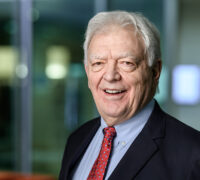
How to ingrain a new habit
In part one of this two-part series, we advised on sparking new habits. Here, in part two, we offer a checklist to help ingrain them. ...

by George Kohlrieser Published 14 September 2022 in Leadership • 8 min read
A senior executive recently told me how, as a teenager, he had assumed the role as head of the household following his parents’ divorce. It was only years later, following his own separation, that he realized that the unresolved grief around his father’s departure had cut off his emotional availability. This had derailed his ability not only to bond with his ex-wife, but also his capacity to lead at work.
He is not alone. Many leaders are struggling to empower and connect with their teams. Remote work during the pandemic, which physically cut leaders off from their employees, allowed mistrust to seep into the working relationship. Almost 80% of American workers said their managers did not trust them to be productive and hard-working during remote working hours. For micromanagers, it has been even more of a nightmare, since they cannot control people at home in the same way as they do in the office.
At the same time, the pressures of remote working have put corporate wellness and compassion into stronger focus. Almost 50% of workers felt “nearly constantly burned out”, and almost 90% of workers felt their wellbeing – that is, their overall mental, physical, and emotional health – had significantly declined by the end of 2021. Moreover, studies show most employees would not feel comfortable speaking about mental health issues to their manager.
Against this backdrop, executives are worried about how to retain and inspire staff. Only 20% of employees worldwide and 36% of workers in the US feel engaged, according to Gallup. And those that don’t feel bonded to their team or a sense of purpose and worth in their work are more likely to leave.
The rapid digitalization of the workplace during the pandemic and a growing number of digitally savvy younger workers has further shifted the traditional power balance between leaders and employers. Managers who are used to holding the wisdom are wondering how they can inspire those who may have more knowledge than themselves in certain aspects of the business. The increasing use of artificial intelligence in the workplace will only serve to exacerbate this power imbalance.

As executives try to make sense of the modern workplace, here’s how leaders can inspire others in a post-pandemic world:
The maxim “before you can lead others, you must first lead yourself” still holds true today. Over the past 20 years, I have taught more than 6,000 executives in the High Performance Leadership program about how to empower and motivate their workers by first understanding their own vulnerabilities, behaviors, and mindsets.
For much of the 20th century, leaders relied on a hierarchical “command and control” management model where the top brass made all the decisions and employed middle managers to get workers to implement them.
They attended executive education programs hoping to learn the traits of successful leaders, and analyzed case studies for playbooks of how to execute change within their organizations.
Since the turn of the millennium, however, there has been growing recognition that leading with authority and fear no longer works. Great leaders become a secure base for others by creating trust, and by providing energy and support to encourage their employees to take risks and seize new opportunities.
But before they can do this, they must first examine their own secure bases and overcome the fears and grief that may be preventing them from reaching their own potential.
The death, loss, and suffering brought about by the COVID-19 pandemic means that companies are grappling more than ever with unresolved grief across their workforce. Employees might not only be mourning lost loved ones, but other losses such as missed weddings, postponed family gatherings, or the cancellation of other valued events.
This unresolved grief costs companies billions of dollars a year in lost productivity and performance, and may derail the leadership capacity of perhaps one-third of senior executives at one time or another.
Leaders who are suppressing trauma related to loss, abandonment, and manipulation may struggle to show empathy and create safe and secure bonds with staff. Others may have empathy in spades but are wary of exerting their authority and fall into the trap of being too nice.
András Incze was one such person. Growing up in communist Hungary, he heard how the Russians seized his family’s property and kicked his grandparents out of their jobs at the end of the Second World War. As an adult, Incze had progressed up the ranks to a global management role at pharmaceutical giant Novartis, but felt he wasn’t reaching his full potential.
Through my work with him, he learned to explore his grief and came to the realization that this inherited trauma was sabotaging his ability to lead. The stories he heard as a child had made him internalize the idea that power was bad, in turn inhibiting his own self-authority. Once he had worked to overcome the fear of his own power, he learned how to keep calm and control his mindset by focusing on the present reality. This gave him the confidence to follow his dreams and start his own consultancy business.
Another person I have worked with whose past trauma was freezing his ability to move forward was Frédéric Meuwly. Abused as a child, he had unconsciously made an association that authority and power were dangerous, and that making yourself visible can be harmful because you can then become prey. While he had worked through the trauma with a therapist, he hadn’t realized the impact this was still having on his leadership. As he was repressing authority, he wasn’t using its positive sides: to protect others, to show the way for a group, and to decide and express needs.
Taking part in the High Performance Leadership program was a major catalyst in Meuwly’s healing process, and through work with coaches he was able to transition his identity from being a victim to a survivor – and, finally, a servant. He is now a published author and runs his own coaching business helping to develop teams.
Allowing yourself to open up emotionally will enable you, as a leader, to bond and have greater empathy with your team. By harnessing the positive sides of authority, Incze and Meuwly both experienced greater clarity of thought and could prioritize vision setting and courage.
It is often a misconception among leaders that their employees are serving them. In fact, the leader’s role is to serve employees, customers, and, increasingly, other stakeholders – for example, communities that might be affected by a company’s business operations.
As people work increasingly in cross-functional teams, leaders will need to draw on their so-called person effect – the power of their state of being, words, and physiology, including status, authority, gender, nationality, culture, age, physical presence, words and language, and energy levels – to connect with others across the organization.
A prominent example of a leader aware of their person effect is the Ukrainian president Volodymyr Zelensky. In mid-March, as Russian missiles pounded Kyiv, the former comedian turned politician walked through the streets of the capital to visit a hospital. Once there, he awarded wounded soldiers with medals for courage and thanked staff for their service. The visit, just one of many public appearances showing defiance in the face of Russia’s invasion, was a masterclass in secure base leadership.
Instead of fleeing Kyiv when Russian tanks rolled across the border, Zelensky stayed and vowed to fight. Through his words and physiology, he demonstrated his compassion for and solidarity with fellow Ukrainians. But he also dares to tell them the truth; that the war will get worse. And he dares to challenge Western leaders to improve their own performance by providing more weapons and imposing sanctions, as well as weaning their nations off Russian oil and gas.

In recent years, organizations have grown more complex and face mounting challenges, from the climate emergency to rising stakeholder activism. While many business executives used to view leadership as transactional, they now need to learn how to build relationships with everyone from employees and customers to those with whom they might disagree.
Great leaders must be open to listen to another’s perspective and to recognize that it isn’t all black and white. They will hear other people’s pain points and learn how to respectfully disagree.
Since completing a High Performance Leadership program in May 2021, Rita French, the British government’s Global Ambassador for Human Rights at the United Nations in Geneva, has worked to build her brand, “Rita Plc”.
Naturally modest and quiet, the program helped her recognize how to stand up, be brave, and make herself more visible by communicating the impact of her work. She has stepped outside her comfort zone by being more present on social media, sought more feedback on her leadership style, and learned to give more constructive feedback to her team as well as more proactive feedback to others.
French shared how the program gave her the confidence to act with courage and conviction. She was among the 100 diplomats who walked out of the UN assembly in March during a speech by Russian Foreign Minister Sergey Lavrov, an act designed to isolate Russia in its actions and show widespread condemnation for the invasion of Ukraine. To ensure the action had the necessary scale and impact, diplomats had to be open and bond with non-traditional allies to convince them to take part, said French. Some countries didn’t want to get caught in a spat between Russia and the West. French had to draw on her negotiation skills to convince nations of the action’s importance. She credits her ability to stand up to intimidators by having secure bases, such as her parents, that have given her the confidence and support to take risks.

Distinguished Professor of Leadership and Organizational Behaviour at IMD
Professor of Leadership and Organizational Behavior at IMD and Director of the High Performance Leadership program. He serves as a consultant to several global companies including Accenture, Amer Sports, Borealis, Cisco, Coca-Cola, HP, Hitachi, IBM, IFC, Jaeger-LeCoultre, Morgan Stanley, Motorola, NASA, Navis, Nestlé, Nokia, Pictet, Rio Tinto, Roche, Santander, Swarovski, Sara Lee, Tetra Pak, Toyota, and UBS.

2 hours ago • by Francesca Giulia Mereu in Leadership
In part one of this two-part series, we advised on sparking new habits. Here, in part two, we offer a checklist to help ingrain them. ...

19 April 2024 • by Marleen Dieleman, Camellia Pham in Leadership
In many ways, overconfidence is advantageous to business owners – but it also carries risks. Taking the time to become aware of how you think and being mindful of the stories you...

19 April 2024 • by Michael R. Wade in Leadership
The EV pioneer’s once-unrivaled dominance is being tested by declining sales, fierce competition, and questions about its commitment to sustainability and innovation. IMD’s Michael Wade examines Tesla’s strategic direction and leadership. ...

19 April 2024 • by Véronique Bogliolo in Leadership
It’s become a cliche that we’re living and working in a VUCA world. All that external volatility, uncertainty, complexity and ambiguity is challenging for sure. But what about what’s going on inside...
Explore first person business intelligence from top minds curated for a global executive audience